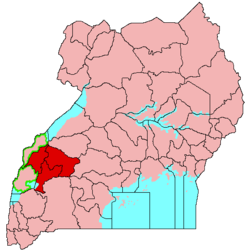|
Tooro Kingdom
   The Tooro Kingdom[a] is a Bantu kingdom located within the borders of Uganda.[1] The current Omukama of Tooro is King Oyo Nyimba Kabamba Iguru Rukidi IV.[1] King Oyo Nyimba Kabamba Iguru Rukidi IV took to the throne of Tooro kingdom in 1995 at the age of just three years, after the death of his father Omukama Patrick David Matthew Kaboyo Rwamuhokya Olimi III on August 26, 1995, at the age of 50.[1][2] The people native to the kingdom are the Batooro, and their language is likewise called Rutooro.[1][3] The Batooro and Banyoro speak closely related languages, Rutooro and Runyoro, and share many other similar cultural traits.[3] The Batooro live on Uganda's western border, south of Lake Albert.[1] HistoryThe Tooro Kingdom evolved out of a breakaway segment of Bunyoro sometime before the nineteenth century.[4] It was founded in 1830 when Omukama Kaboyo Olimi I, the eldest son of Omukama of Bunyoro Nyamutukura Kyebambe III of Bunyoro, seceded and established his own independent kingdom.[3][1] Absorbed into Bunyoro-Kitara in 1876, it reasserted its independence in 1891. As with Buganda, Bunyoro, and Busoga, Tooro's monarchy was abolished in 1967 by the Government of Uganda, but was reinstated in 1993.[1]  Cultural influenceThe Austrian painter Friedensreich Hundertwasser (1928–2000) spent some time there in the 1960s where he painted a number of works and named them after the kingdom.[5][6] The Batooro people have a strong culture but similar in stratification to Banyoro.[2] They have got a strong cultural naming system (PET NAME) known as Empaako.[7][8] With the Empaako naming system, children are given one of twelve names shared across the communities in addition to their given and family names.[8][9] Addressing someone by his or her Empaako is a positive affirmation of cultural ties. It can be used as a form of greeting or a declaration of affection, respect, honour or love.[8][7] Use of Empaako can defuse tension or anger and sends a strong message about social identity and unity, peace and reconciliation.[8][10] The Empaako names are: Amooti, Abbooki, Akiiki, Ateenyi, Adyeri, Atwoki, Abwoli, Araali, Acaali, Bbala, and Okaali.[8][10][9] Abakama ba Tooro (Kings of Tooro)The following is a list of the Abakama of Tooro since 1800:
See alsoBibliography
NotesReferences
External links
Information related to Tooro Kingdom |
||||||||||||||||||||||||||||||||||||||||||||||||||||

